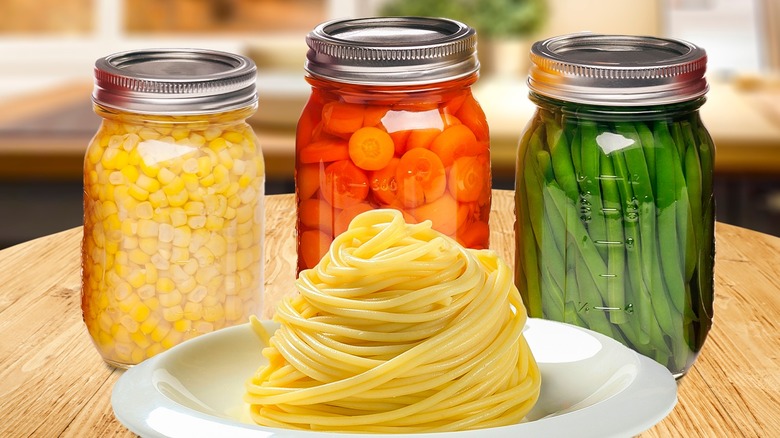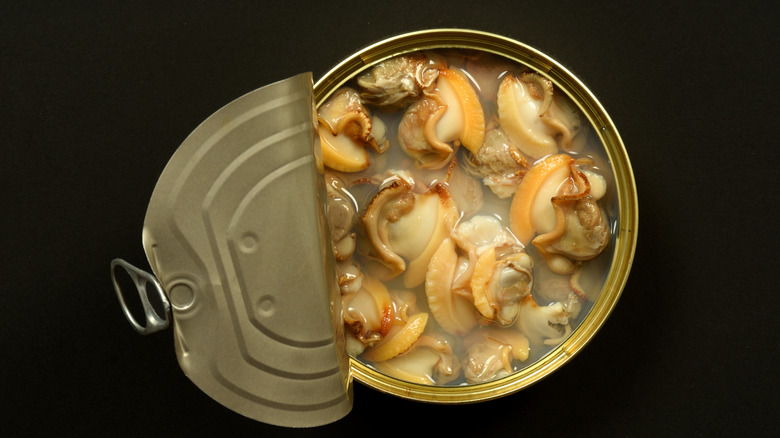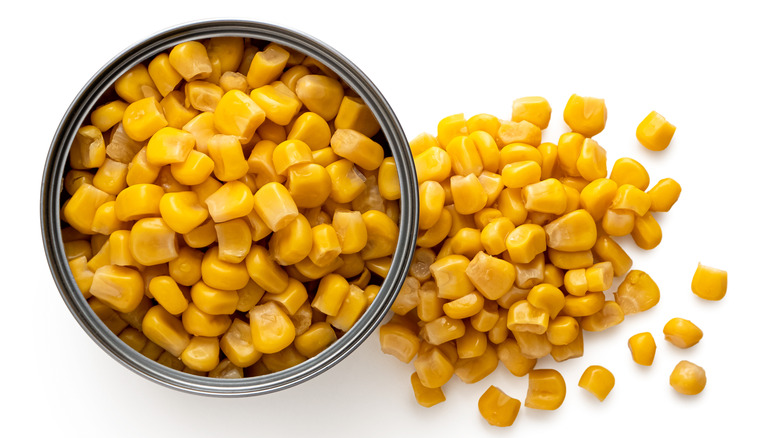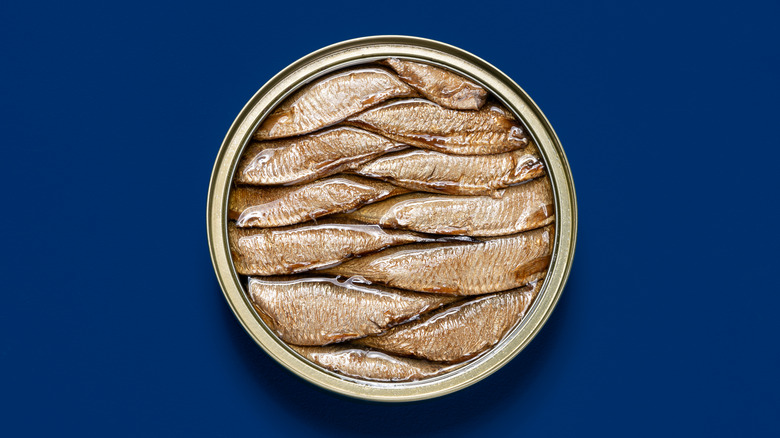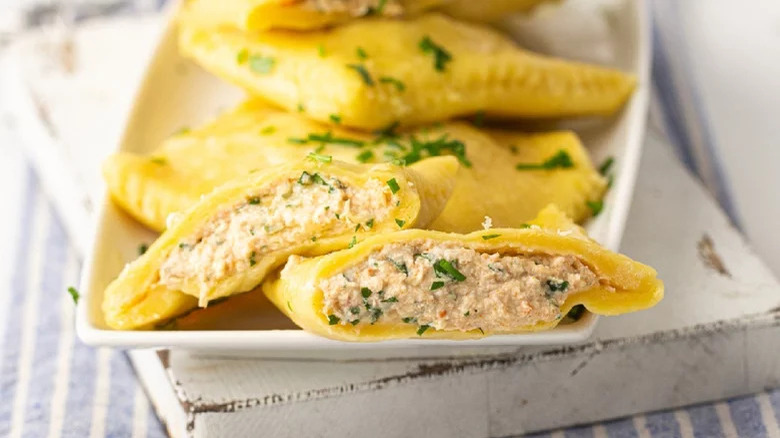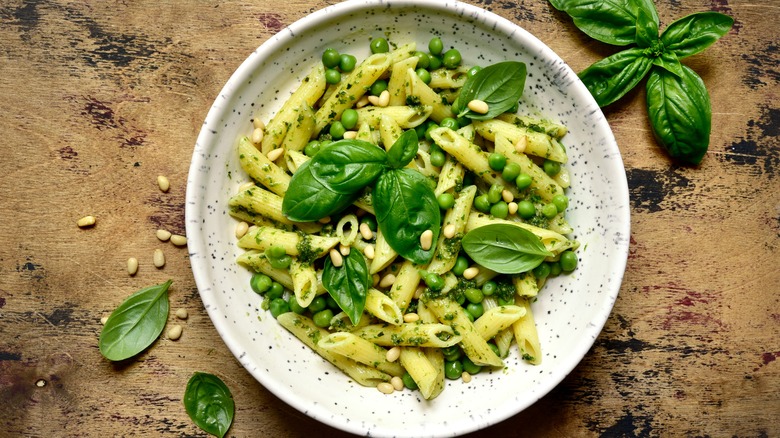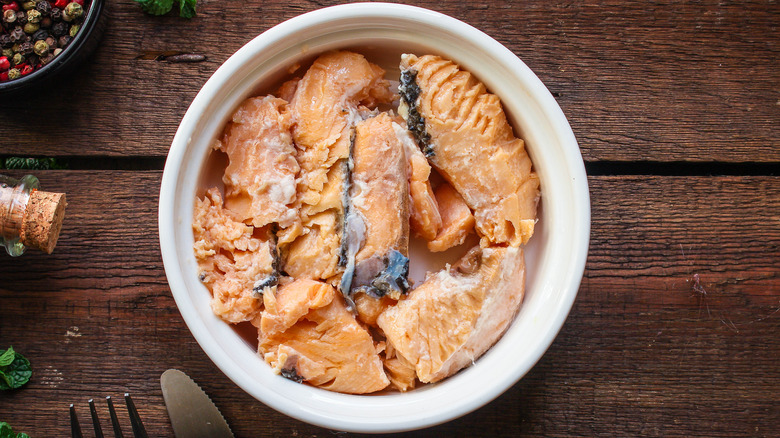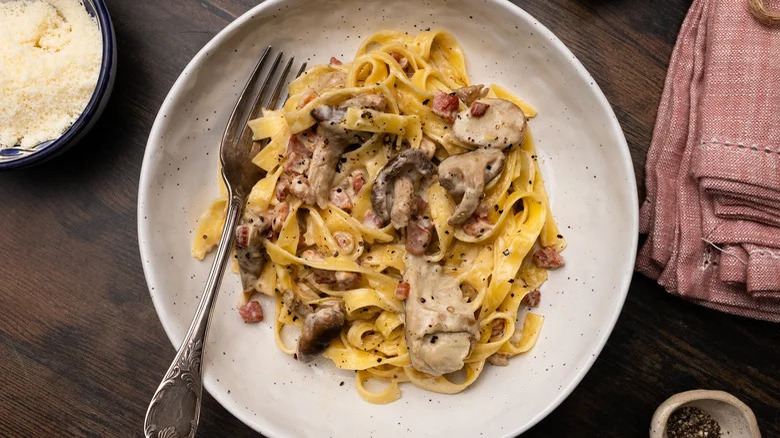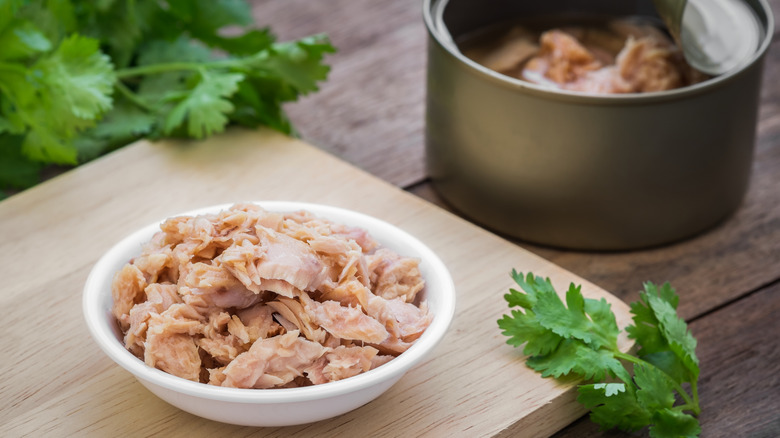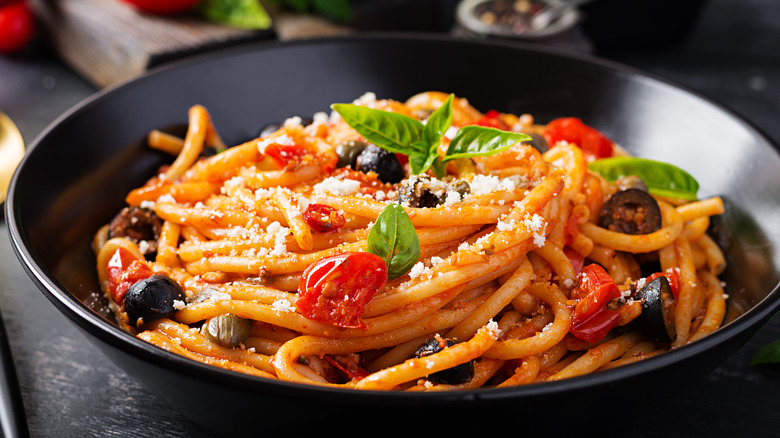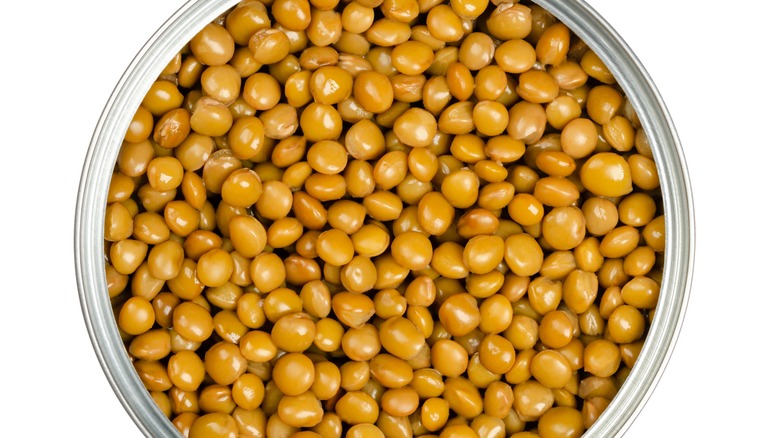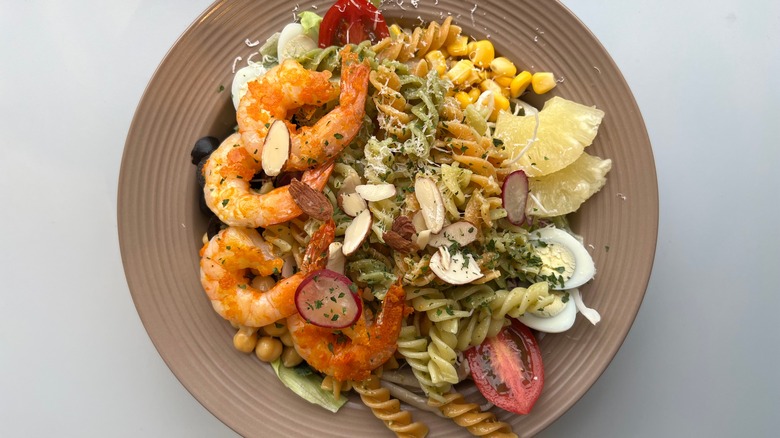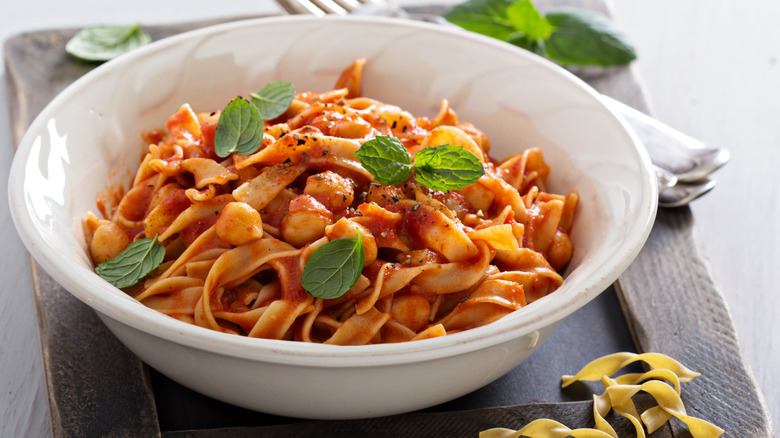19 Canned Foods You Need To Start Adding To Pasta
Canned foods are a convenient delight to stock in your pantry, ready to use when you need them. Compared to fresh produce, meats, and seafood, the canned variety has a long shelf life. This gives you flexibility and reduces the stress of coming up with a way to finish day-old salmon or wilted spinach that you forgot about in the fridge. When it comes to pasta, there's canned fare for every dish, whether it's served hot or cold, in salad form, used as a topper, a helpful flavor enhancer, and more.
When you want to mix taste and comfort, there are plenty of enticing and delicious canned foods you need to start adding to pasta — from blending them to sauces to mixing them to make hearty fillings. This post is your guide if you want to utilize canned pantry staples to add flavor, texture, and depth to your dishes. We have tons of pasta recipes to keep you inspired as you discover the endless ways to use these canned goods in your cooking.
Artichokes
While we love the taste of artichokes, we don't enjoy the cooking process. It's a lot of work and a mess, too. Canned artichokes eliminate these issues and make a memorable addition to your pasta. Try using it in a creamy, garlicky, easy chicken artichoke pasta that makes an ideal weeknight dinner. You have everything you need for a satisfactory meal, including chicken protein, starchy pasta, and artichokes as vegetables.
It takes under 40 minutes to prepare and cook. Even as you make it, you're able to maximize your time by preparing the sauce and heating the artichokes while the chicken bakes. The artichokes are already cooked and soft, so they only need to warm against the sauce's heat. The green veggie adds an earthy and tender component to the creaminess of the sauce.
Clams
Canned clams don't have to be relegated to tinned fish platters only. They're the canned seafood you should be adding to tomato sauce for a briny factor without a lot of extra work. There's no cleaning or shucking needed. Leave it at one can or do two if you want more of a punch, and include freshly chopped herbs, or a make zingy arrabbiata sauce with red chili pepper flakes.
Canned clams are a more affordable version of linguine than fresh clams, making them a delicious meal perfect for entertaining a crowd. You can buy several pounds of canned mollusk for around the same price as one pound of fresh. A plate of linguine is a fantastic option to make a balanced meal without the extra cleaning work. Its chewy meatiness completes the meal within a few minutes and gives your pasta an upscale taste.
Corn
There are a couple of exciting ways to integrate corn into your pasta. To create a tasty sauce, blend up canned corn to make a creamy mixture that you can combine with white wine, cream, or additional spices for dimension. This is incredibly diverse since you could add your choice of herbs, spices, or cheeses to make a silky, flavorful sauce. Place the ingredients in the blender to make a smooth sauce you can pour over your desired noodles.
Go a different route by adding canned corn for a better mac and cheese. The food combination makes a filling dish but also provides dimension in flavor with a slight sweetness. All you need to do is add the drained corn to the pasta once cooked and prepare it as usual. There are no extra steps needed, other than draining it, which is always appreciated.
Sardines
Canned sardines are a nutritional powerhouse with protein, fat, calcium, iron, omega-3 fatty acids, and other vitamins and minerals. Sardines tend to taste fishy and are not a canned food that hides in the shadows. This fish makes its flavor known, which makes it one of the canned foods you need to start adding to pasta. It has a salty, nuanced flavor depending on whether it's packed with oil or brine, smoked, or other options.
Make almond, dill, and sardine bucatini for a herby pasta with a rich tomato sauce, or incorporate it into your favored pasta as a protein component with an umami-packed bite. It tastes good in any sauce, whether it's cream, oil, or tomato-based. But factor in what it's combined with, such as sardines packed in tomato with a tomato-based sauce. It's the perfect addition for a soft, easy-to-eat fish.
Carrots
When you want to cut the acidity of pasta sauce or need a colorful ingredient, try adding canned carrots. Rather than washing, peeling, and dicing the fresh vegetable, the canned variety is a delicious timesaver. You don't have to cook it ahead of time; just add your carrots, tomato sauce, and a bit of sugar for an upgraded spaghetti and meatballs your family will love.
The sweetness of the sugar and carrots helps balance the tanginess of the dish while boosting the nutritional value with calcium, magnesium, potassium, vitamin A, vitamin C, and more. You can make it a star ingredient by adding canned carrots to brussels sprouts fettuccine for an ultra-colorful pasta dish that you can pair with baked salmon or grilled chicken. Lightly warm the carrots in a pan and place them on top of the pasta.
Crab
Date night just got an upgrade with crab ravioli using the canned crustacean. Before making your crab meat mixture, check for any crab shell pieces or bones before combining it with your fresh herbs. This is a simple mistake you're making when using canned crab meat, but it's a simple fix. You can also freshen it up in a milk bath. The crab ravioli takes some time for the dough to set, but after that, everything comes together, and it only takes a few minutes to cook.
These are a delightful way to showcase how incredible the delicate and sweet flavor of canned crab can taste. The creamy ricotta cheese and a hint of lemon juice elevate the dish further. These pasta morsels shine on their own with melted butter, but you could serve them with any number of pasta sauces.
Peas
When you want a canned good that adds a pop-up color and can be used in hot and cold pasta dishes, peas are your best friend. Let them warm, and then add them at the end when you're plating your favorite pasta, like penne with pesto and pine nuts, for a hint of sweetness that isn't overpowering. Or make garganelli with morels and peas and lamb for an earthy dish often associated with springtime. It looks and tastes restaurant quality with its morels and creamy marsala wine sauce.
Canned peas are one of the main ingredients in German pasta salad, along with crunchy pickles, bologna, and mayonnaise dressing. There are a couple of varieties, such as fleischsalat with German bologna and peas and Nudelsalat with spicy mustard and tangy pickle juice mayo dressing, that are perfect for taking to a potluck when you want to mix up the standard pasta salad.
Spinach
There aren't many things that most people have experienced as a collective, but who hasn't bought a package of spinach only to forget about it in the back of the fridge? This doesn't have to be a problem if you use canned spinach. There are plenty of creative ways to use canned spinach in pasta, like stuffing it into lasagna or manicotti for a leafy inclusion or making spinach and balsamic cream pasta.
Use it to add more flavor to store-bought pesto to smother all over your favorite pasta. The spinach is disguised in pesto since it's blended, which can be a fantastic option if you don't like the weird feeling or film that spinach leaves on the teeth. It enhances the sauce's color while also providing nutritional value with its fiber, calcium, iron, magnesium, and other nutrients. If wateriness is a concern, drain the liquid and squeeze out any excess before mixing it into your dish.
Salmon
Every second counts when it comes to using fish, so if you forget it in your fridge for a day, its freshness goes down, which is the appeal of having the canned version. If you haven't tried canned salmon in pasta, you're missing out on a colorful, flavorful fish. It eliminates the cooking process, but it still has nutritional value, which includes protein, fat, vitamin D, phosphorus for bone strength, and more.
The skin and bones can offer texture, but you can find boneless and skinless, too, or give the pasta a smoky profile with smoked salmon. Leave them in larger chunks for a more fishy bite, or mash them so they're more incorporated into your dish. Eat this canned seafood in pasta dishes along with chopped chives or dill for a fresh addition. As for sauces, you can go the creamy route or try something lemony for a tangy component to complete the salmon.
Mushrooms
With the canned variety, you don't have to worry about fishy, mushy, slimy week-old mushrooms. You can pick the type that works for your particular meal, whether you want whole, pieces and stems, or sliced. While they have an earthy element, they also absorb a lot of flavor that can level up your dish. Try them in a pancetta and mushroom skillet pasta, substituting fresh mushrooms entirely for canned, or do half wild mushrooms, half canned, and cook as directed.
Follow a designated mushroom pasta recipe, or make your favorite pasta and add mushrooms as a vegetable component. When you want a quick weeknight meal, make a simple meatball pasta bake and include mushrooms. Use your canned mushroom pieces or chop them into smaller bits so they're not as noticeable.
Tuna
Tuna is an adaptable tinned fish that you can find packed in a few ways so you can discover the best version for your distinct pasta dish. When you crave simplicity, you don't need much to make a comforting Italian pasta dish, spaghetti tonno e burro — just pasta, canned tuna, and butter. Opt for tuna packed with oil for the recipe since it tastes richer and will stick to the pasta. Since the tuna and butter form a mouthwatering sauce, keep the seasoning straightforward with salt and pepper.
Make a cold dish, such as tuna pasta salad, for a delightful summer meal. This is not your average pasta salad since it has unexpected ingredients, such as crème fraîche and breadcrumbs. Use tuna packed in brine or water because an oil-based one will make the pasta far too oily. The dressing is creamy but punchy and will stand out from other cold salads.
Tomatoes
When you're seeking one of the most versatile and common canned items for pasta, tomatoes are the top choice. If you want something more top-tier, opt for San Marzano tomatoes. These are a popular canned tomato choice because they have lower acidity and a slight sweetness that you can make into a tomato sauce to go with any pasta you want. Canned tomatoes might even be better than fresh, depending on the season, since canned are often packed at prime freshness.
Use canned tomatoes to make macaroni and tomatoes, which is a classic, quick meal that everyone will love. But you could also use the canned good to make the sauce and then add more flavor by including salt, garlic, olive oil, or fresh herbs such as oregano, basil, parsley, or thyme. If you're seeking convenience, sprinkle in premade Italian seasoning for depth. Blend the tomatoes for a smooth sauce or crush it by hand or with a spoon for a heartier texture.
Olives
Olives can give pasta a salty, bold flavor. Canned olives come in an array of options, such as green, black, sliced, or whole. When you want to mix up the texture, olives bring a briny and meaty element to pasta. You could even use an olive tapenade instead of sauce on your pasta to elevate a simple dish. The green olives have a more herbal quality, whereas black olives have a deeper flavor. Add olive oil, lemon, and fresh herbs for color and unique aromatics as an alternative to other sauces.
You could also incorporate the olive brine itself to make a sauce. Whether you go for Alfredo or marinara, you can upgrade the sauce by pouring in a bit of olive brine, mixing it, and tasting it to see if it needs more. Olives work well with any pasta shape but pair particularly nicely with long kinds of pasta, like angel hair or spaghetti.
Chicken
There are many protein sources that you can include in your pasta, and canned chicken is an easy, fantastic option. It eradicates the cleaning and sanitizing rigamarole you must undergo after cooking with chicken since the canned option is cooked and ready to eat out of the can. You can mix it into or onto any pasta that calls for chicken. The only caveat is that the pieces are smaller and more bite-sized than, say, a whole chicken breast or thigh.
Eat it in a creamy chicken spinach pasta bake, swapping the fresh chicken for the canned version to save you time. Make it as instructed, except add the chicken after the bacon is cooked, and then follow the directions to make this flavor-packed meal for the entire family. It's a comforting dish to pop in the oven and serve any time of the week.
Lentils
You'll often find this legume in soups and stews, but it's one of the best ingredients to take your pasta to the next level. Lentils are not only of great value but also contain nutritional components like fiber, protein, potassium, iron, magnesium, and more. This filling and nutritious canned legume is excellent to add to pasta dishes when you don't want to cook them from scratch.
Lentils are also a wonderful meat alternative because they absorb a lot of seasoning, making them a perfect choice to bolster bolognese or add to alfredo sauce. It can easily be incorporated into lasagna or any other dish. Since they're cooked, it's best to integrate them toward the end of the pasta cooking process, such as when you're putting everything together or mixing it with sauce, so they don't get too mushy.
Pineapple
If pineapple on pizza isn't your thing, you might want to skip this tip because the yellow fruit is an excellent addition to sweet and spicy seafood pasta. Substitute fresh pineapple for canned, opting for larger pieces such as pineapple chunks or pineapple slices that you can cut into your desired size. You'll also want to pick pineapples in pineapple juice rather than in syrup.
The pineapple juice won't alter the flavor or give it a funny consistency the way the syrup might. This is an ideal weeknight dinner since it takes 20 minutes from start to finish. It's hearty with seafood such as shrimp, scallops, and seabass. While this fruit might not be something to add to any old pasta dish, you can strategically include it when you want a sweet but tangy twist.
Anchovies
When finagling your meals for the week, you might want to incorporate weeknight carbonara with anchovies into your rotation. It makes the quintessential last-minute meal since boiling the pasta is the most time-consuming component. The anchovies heat up in a pan with oil, garlic, herbs, and more to create a delectable meal. The little fish might not be everyone's favorite, but it's an excellent choice when you want to give a savory depth to a plain carbonara.
Anchovies are ready to consume straight from the tin, so heating them in the pan allows them to warm up to match the temperature of the rest of your ingredients. Canned anchovies have protein, vitamin B3, vitamin B12, selenium, and other nutrients, making them a nourishing tinned food option to keep in your pantry. While some don't love anchovies, we think you should give this pasta dish a shot since the saltiness makes a prime alternative to other carbonara meats like guanciale or pancetta.
Chickpeas
If you're looking for something that can be added to many types of pasta dishes, look no further than canned chickpeas. While you might know them from being used in hummus or in chickpea flour for baked goods, these are classified as dried peas and stand out from other beans with their unique shape and mellow, nutty flavor. Try them in the Roman specialty pasta e ceci, which translates to pasta and chickpeas. This broth pasta dish is filling and only takes about 10 minutes to cook since you don't have to cook the chickpeas for two hours. It's a warming meal that's perfect for a cold evening when you want comfort food.
Go for something different by using the liquid, known as aquafaba, to thicken pasta sauce. These round legumes make an unknown addition because they have a gentle taste that's camouflaged with the acidity of the tomato sauce but still gives it a creamy texture. It works superbly with vodka, tomato, or Alfredo sauces.
Other beans
If you're like us, you might have a bunch of canned bean varieties in the pantry, whether that's black, cannellini, kidney, or something else. Many types of canned beans exist and are easily one of the top canned foods you need to start adding to pasta. Make a black bean and corn taco pasta with canned black beans that will shake up your average meal. This is fun, colorful, and a huge time saver since you're not cooking the beans from scratch. It also has crispy elements like tortilla chips and fresh cilantro for an unexpected, fragrant meal.
You could also boil the pasta in bean broth for extra flavor, whether you choose pinto or Great Northern beans. The average canned beans have salt and a slight starchy component, making an excellent base for your pasta, no matter which shape you choose. It upgrades the flavor while also thickening it.
